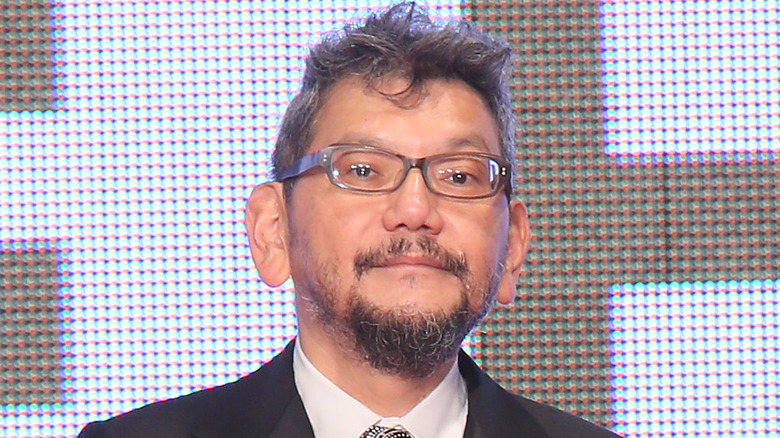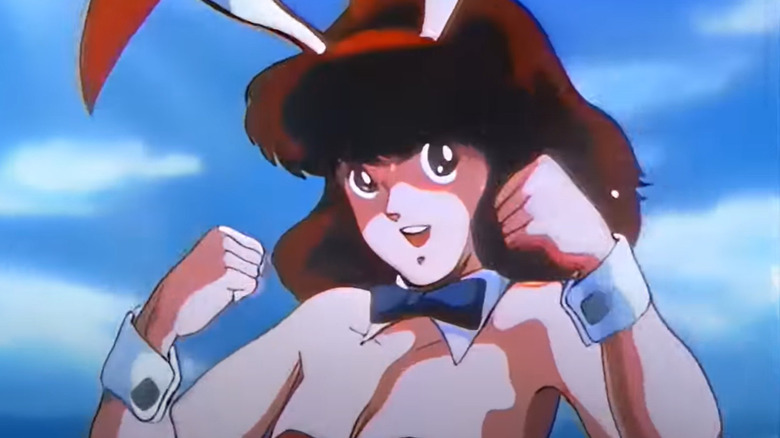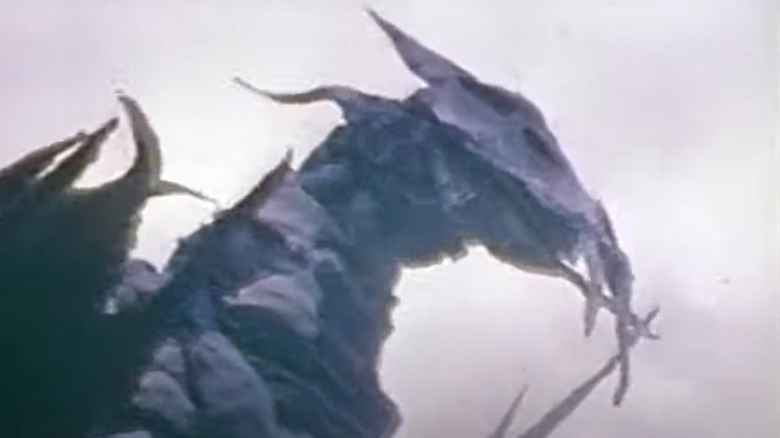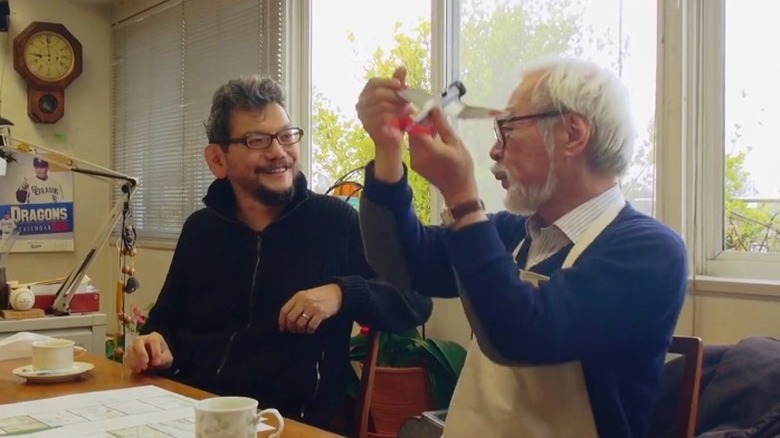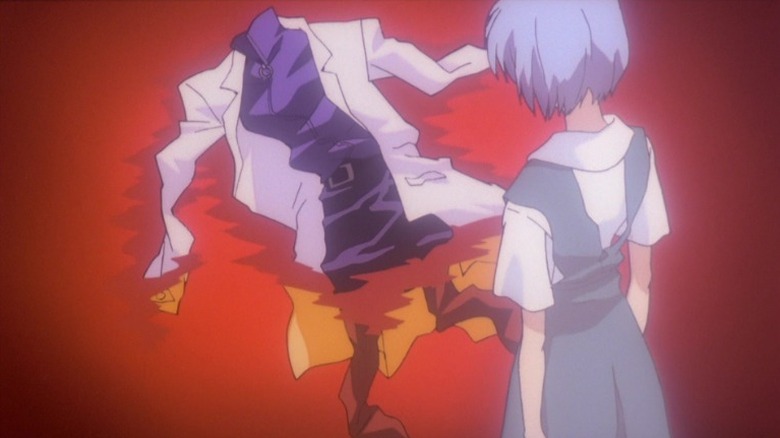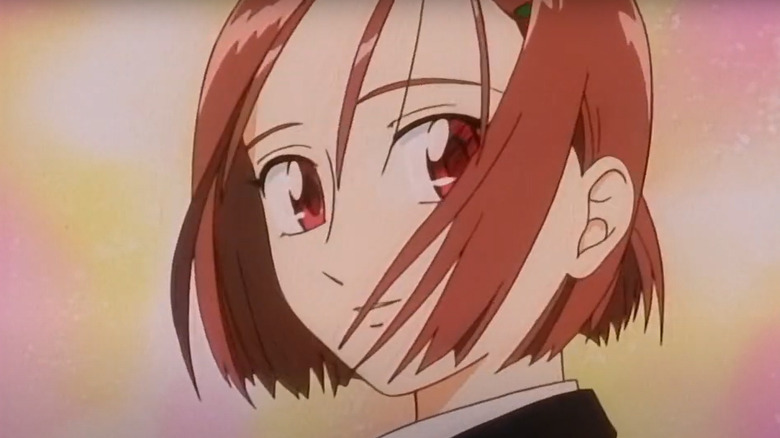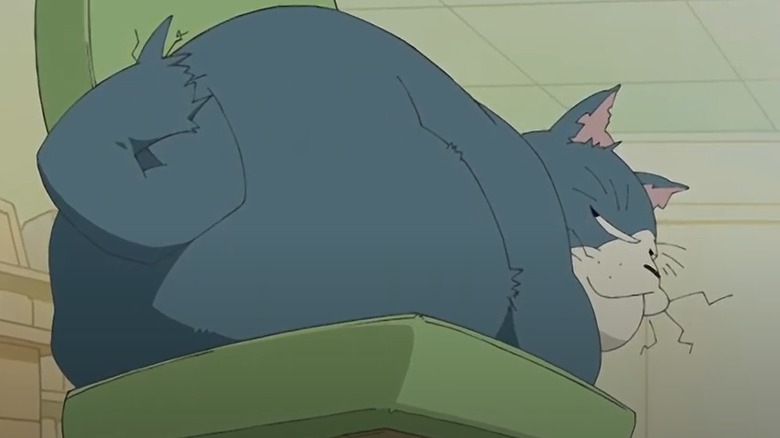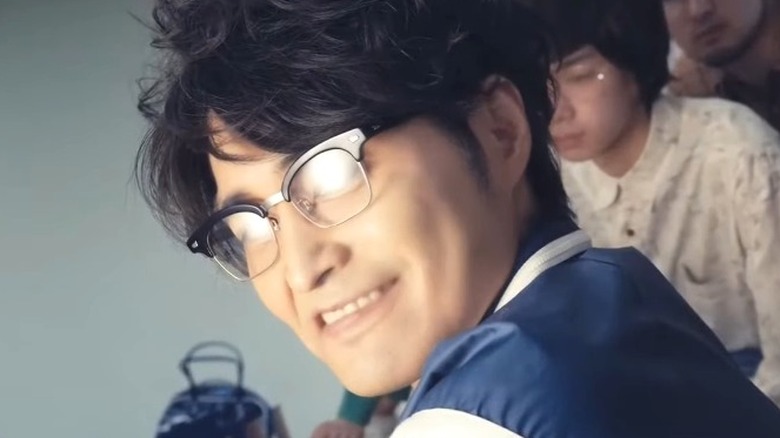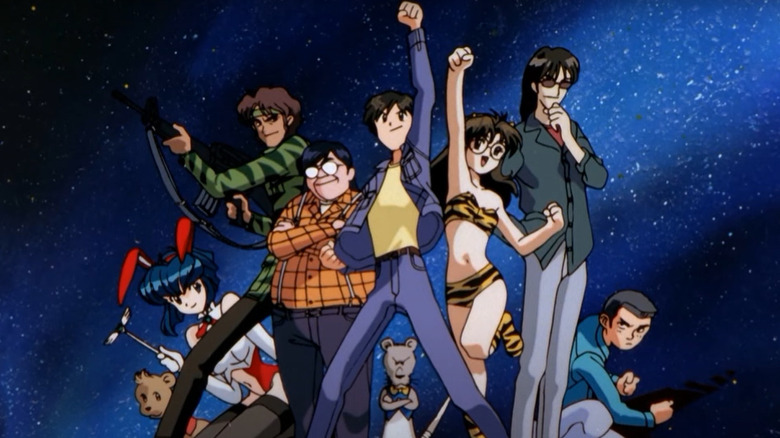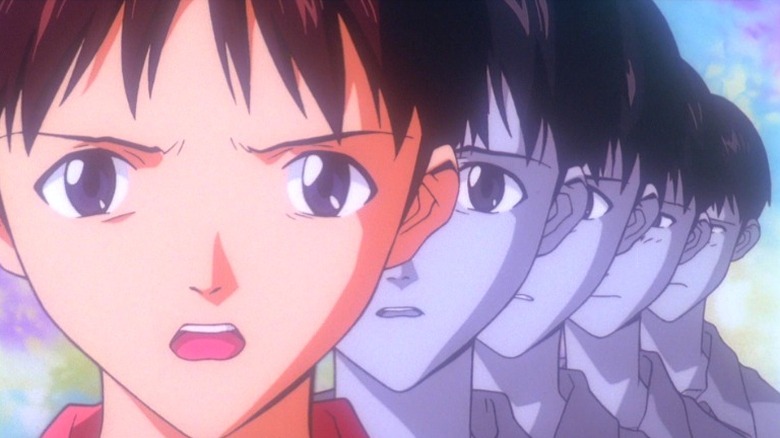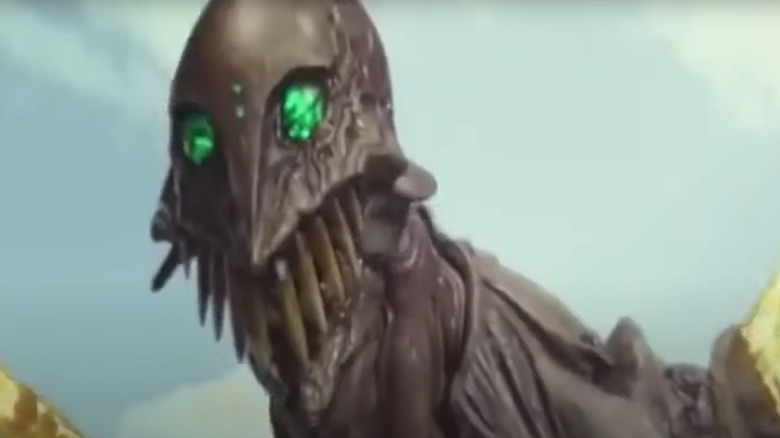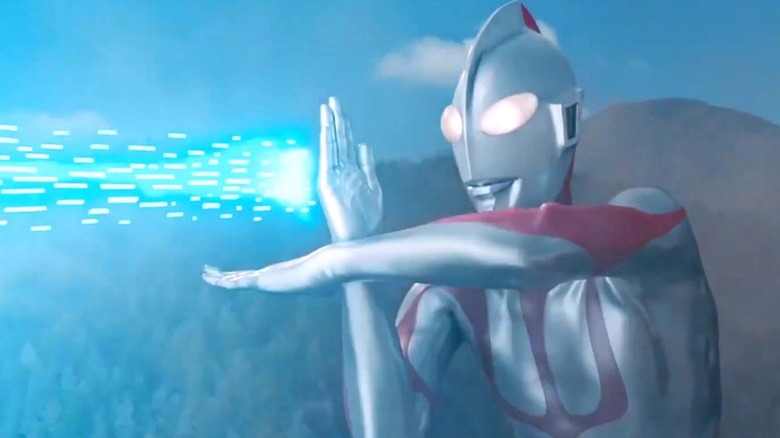The Untold Truth Of Hideaki Anno
The founder of Gainax and creator of series like "Neon Genesis Evangelion" and films including "Shin Godzilla," Hideaki Anno is one of the most admired and intriguing figures in Japanese media. His role in the emergence of otaku culture (what's referred to as "nerd culture" in the U.S.), his use of innovative techniques in both live action and animation, and his ability to write characters struggling with personal conflicts have all made him one of the most interesting creators in existence. However, this has earned him both worldwide praise and toxic criticism.
In order to analyze Hideaki Anno's work, it's necessary to understand his interests and personal issues. People may have heard about his admiration for the tokusatsu genre and his fight with depression, but his repeated collaborations with Studio Ghibli, his many efforts in manga, anime, and live action, as well as his work as a songwriter and even in motion capture may surprise even the most loyal of admirers. Today, we will take a look at one of Japan's most fascinating storytellers. Here's the untold truth of Hideaki Anno.
Note: This article contains spoilers for "Neon Genesis Evangelion," "The End of Evangelion," and mild spoilers for "Kare Kano."
Anno made anime convention history with DAICON III
Today, anime and manga conventions attract hundreds of thousands of attendees. Fans, cosplayers, and doujinshi artists can explore a vast market of Blu-rays and books and even meet famous artists and voice actors. In the early 1980s, though, conventions were rather small. People could still meet to discuss or buy their favorite movies and manga, but there were no other forms of entertainment. That changed in 1983 when organizers of the Osaka-based DAICON decided to hire a team of animation students to create a five-minute short to start the event.
According to Crunchyroll, the team, which included Gainax founders Hideaki Anno, Takami Akai, and Hiroyuki Yamaga worked intensely and under poor conditions to animate the short. The result was "DAICON III," an exciting short filled with impressive animation techniques seen in franchises like "Gundam," upbeat although unauthorized music, and an overwhelming number of references to popular culture including appearances by Godzilla, Gamera, and Gundam 0079. The team would return with a bigger budget the following year to produce an even more ambitious version called "DAICON IV," in which Darth Vader, Captain America, Batman, and even more imaginary characters join in on the mayhem.
As years passed, the short acquired a legendary status among fans. In fact, it has been referenced repeatedly across anime and live-action media. The bunny costume worn by the protagonist of DAICON would make appearances in "Otaku no Video" and "FLCL," and the short also inspired the opening of the otaku-centric romantic comedy "Densha Otoko." The short is considered so important that in 2021, Polygon reported that a team of fans were working on a restoration project before Gainax itself asked them to stop as they had started working on their own remaster.
Anno's directorial debut was a live-action Ultraman fan film
Anno's first big success came from the acclaimed series "Neon Genesis Evangelion" in the mid-'90s. At the time, fans and critics praised its innovative animation techniques and its deconstructive approach to the mecha anime genre. Nevertheless, many viewers failed to notice that Anno's influences in creating "Evangelion" went beyond anime franchises like "Gundam" or "Macross." In fact, the root of Anno's interest in giant robots could be traced back to his fascination with movies and series that rely heavily on special effects.
The tokusatsu genre, as it is known in Japan, includes monster movies like "Godzilla" and series like "Kamen Rider" and "Super Sentai." Among all these, Anno's favorite was without a doubt "Ultraman," a show in which an individual fuses his body with an alien in order to transform into a giant and fight evil monsters. The franchise and, in particular, "The Return of Ultraman" series ended up inspiring Anno's first directorial debut. The fan short, titled "Return of Ultraman: MAT Arrow 1 Takeoff Order," has an impressive quality considering the staff had to create every single prop and piece of wardrobe from scratch, as cosplay stores didn't exist at the time.
Hideaki Anno and Hayao Miyazaki have collaborated on multiple projects
The work of Hideaki Anno varies greatly in tone. He can immerse audiences in Arima's troubled mind in "Kare Kano" and provide a hilariously nonsensical short about train passengers in "Ryusei-Kacho." However, he's not the only director capable of making audiences both laugh and cry. Hayao Miyazaki, the founder of Studio Ghibli, has created unforgettable works of art like "My Neighbor Totoro" and "Princess Mononoke." Interestingly, Anno and Miyazaki share a mutual admiration that has fostered multiple collaborations.
The first one took place early in Anno's career. As seen in "The Birth of Studio Ghibli," in 1983, the production of the studio's first feature, "Nausicaa of the Valley of the Wind," was behind schedule. As a result, the staff was forced to post an ad looking for animators. Anno saw the ad and decided to show his portfolio to Miyazaki. Impressed with his talent, the director assigned him the most ambitious scene in the film — the attack of the Giant Warrior. Anno didn't disappoint, creating a powerful scene of devastation that would become one of the most memorable sequences in the movie.
The studio brought Anno in again to do some key animation for Isao Takahata's "Grave of the Fireflies." Years later, motivated by a frustrating casting process, Miyazaki asked the now-renowned director to try for the main role in his next film, "The Wind Rises." In Episode 4 of NHK's "10 Years with Hayao Miyazaki," the studio's founder can be seen reacting with a contagious enthusiasm to the idea of Anno voicing Jiro Horikoshi. The director would be chosen for the part, delivering a touching performance in one of Miyazaki's most personal films.
Anno wrote the most important song in The End of Evangelion
During the original broadcast of "Neon Genesis Evangelion," fans felt captivated by the intriguing storyline and characters. The series provided a great balance of action and dialogue, at least during the first 24 episodes. For episodes 25 and 26, though, the series would take the form of a deep introspection that unfolds entirely inside the mind of main character, Unit-01 pilot Shinji Ikari. The ending brought audiences an excellent ending to the protagonist's arc, as Shinji finally realizes that his failure to connect with others is caused by his lack of self-acceptance. Nevertheless, the sudden change in tone was so disappointing for some fans that they reacted with intense criticism and even death threats.
In response, Anno created "The End of Evangelion," an action-filled film that changes Shinji's self-improvement arc for one in which his reluctance to admit his flaws leads to the end of the world. Furthermore, during a terrifying sequence in which the angel Lilith approaches each human being and obliterates their individual forms, Anno decided to include a song that combines an upbeat and ironically comforting melody with dark lyrics that hide an important message. The original Japanese lyrics of "Komm, süsser Tod," written by Anno himself, reflect not just the protagonist's selfish thoughts, but also the unhealthy attachment some fans had developed toward certain forms of escapism. The lyrics were ultimately translated into English for the final cut, losing some of their meaning in the process.
Neon Genesis Evangelion isn't the only series he couldn't finish
In 1996, when "Neon Genesis Evangelion" ended, the drastic change in tone the series took in the last two episodes caused significant backlash and upheaval. This wouldn't be the last time Anno was involved with an endeavor that changed direction mid-production. For their next project, Gainax asked Anno to direct their adaptation of Masami Tsuda's high school romantic comedy "Kare Kano." Revitalized by the opportunity, the director infused the series with innovative techniques like basing some animations on panels from the original manga, adding ridiculously dynamic action scenes, and even live-action footage. He also depicted the protagonist's struggles with mental illness and trauma in a relatable and sympathetic manner, while leaving space for hilariously comedic moments.
Sadly, as explained by Hiroyuki Yamaga during an interview, the author of the manga wasn't very pleased with this last component. As a result, Anno had to leave the production midway through the series. Ironically, due to budget constraints, the last episodes had to use narration over static images and even puppets, ending without providing a conclusion to the ongoing arc (via Anime News Network).
The director has had multiple cameo appearances in anime and live-action productions
Since "Kare Kano," Hideaki Anno's work has oscillated between high-profile and small-budget productions. But regardless of whether he is directing sagas like the "Rebuild of Evangelion" films or writing a low-budget adaptation of "Cutey Honey," Anno usually chooses projects that are meaningful for him or simply fun. This, together with the admiration he has gained within the Japanese media industry, made him the perfect candidate to make multiple cameo appearances in anime, live-action productions, and even TV ads.
Anno's first anime cameos came, logically, from Gainax productions, choosing unusual characters to better hide his voice. In the celebrated "FLCL," for example, he voiced the cat Miyu Miyu. For "Magical Shopping Arcade Abenobashi", on the other hand, he decided to voice an alien. Anno is also credited with cameos in the live-action adaptation of "Otakus in Love," as well as the surreal film "The Taste of Tea." Finally, the director can be seen in numerous TV ads for different car brands like Nissan and Honda. More recently, he was prominently featured in a commercial for Sapporo Beer where he can be seen reflecting on the meaning of money (via Sora News).
Hideaki Anno has been featured as a character in manga, anime, and a live-action drama
The director of the "Evangelion" franchise has lived a unique life. During his meteoric rise to fame, he crossed paths with multiple animators that would go on to become renowned writers and directors. In addition, his innovative way to shoot and write both anime and live action has created a strong demand for interviews and books providing a glimpse into the mindset of the brilliant director. Ironically, this has also turned him into one of the better-known figures in anime, thanks to his appearance as a character in multiple forms of media.
In 2002, successful manga author Moyoco Anno decided to release "Insufficient Direction," a chronicle of her married life with the famous director. More than a deep dive into the complex mind of the "Evangelion" creator though, the manga, which was later adapted into an anime series, depicts what it is like to live with an otaku. Similarly, in 2007, artist Kazuhiko Shimamoto decided to create a manga depicting his life in college, where he happened to meet more than one famous animator. "Blue Blazes" offers humorous takes on his encounters with Gainax founders Hiroyuki Yamaga and Hideaki Anno. The manga was later adapted into a live-action series in which we can see Ken Yasuda, who voiced various Studio Ghibli characters, play a younger version of Hideaki Anno. Finally, the director would also be portrayed in the anime "Shirobako", together with other famous creators (via Otaku USA Magazine).
Anno has a conflicted relationship with otaku culture
Hideaki Anno is considered an innovator and early adapter of otaku culture. Not only did he avidly record and analyze anime series and attended conventions, but he also went into producing his own fan films, launching his career in the process. Sadly, the toxic criticism he received from some "Evangelion" fans led him to become disenchanted with otaku culture.
In a 2012 interview with 2channel (via Otaku USA Magazine) Anno expressed that some fans become too attached to certain forms of entertainment and that he had given up on reasoning with them. His repeated comments on this issue have led him to be mislabeled as a person who hates otaku culture. It doesn't help that Gainax's satire documentary "Portrayal of an Otaku," in which different members of the studio's staff, including Anno, play exaggerated versions of anime fans, could be interpreted as a confirmation of the director's disenchantment with that subculture. To make things worse, according to Japan Today, Studio Khara, the company behind the "Rebuild of Evangelion" series, received several threats during the production of the franchise's last installment.
Despite all this, Hideaki Anno seems to have learned to cope with this aspect of his work and embraced his otaku persona. He's not only left a heartwarming foreword on his wife's manga where he is depicted as an enthusiastic fan of anime and special effect series, but he has gone on to curate a tokusatsu miniature and props exhibition, provide multiple interviews about the "Rebuild of Evangelion" series, and co-direct and write the 2016 kaiju reboot "Shin Godzilla."
Hideaki Anno's character arcs parallel his struggle with mental illness
Hideaki Anno has a long history of coping with depression. In fact, some of his experiences may have permeated into his work. It's not unusual to see some of his characters struggling with sadness, irritability, and self-aggressive thoughts. Shinji Ikari, for example, fears rejection and tends to blame himself when his social interactions don't go as planned. In "Kare Kano," Arima's fears of losing Yukino and his general mistrust of others lead him to become extremely jealous and even violent. In both cases, the characters' inability to identify their own personal issues becomes an obstacle to their happiness, but they eventually overcome this with the help of their friends.
Interestingly, Anno's own struggles with mental illness seem to have followed a similar path. After "Evangelion," for example, word of his deep depression reached Hayao Miyazaki. The director of films like "My Neighbor Totoro" and "Castle in the Sky" decided to call him and have an honest conversation with his friend. During this call, Miyazaki told Anno that it was perfectly fine to take a long break before starting work again. He also reminded him that, whatever he chose as his next project, he was sure people would be happy to see it. According to Anno (via Anime News Network), these words helped him feel better at a time when he thought depression could have cost him his life.
If you or anyone you know is having suicidal thoughts, please call the National Suicide Prevention Lifeline by dialing 988 or by calling 1-800-273-TALK (8255).
He helped Studio Ghibli create its first live-action production
Hideaki Anno has a well-documented admiration for the tokusatsu genre. Apart from starring in his own "Return of Ultraman” fan film and writing the live-action adaptation of "Cutey Honey," he directed a behind-the-scenes documentary about the film "Gamera 3" and co-directed and wrote the script for "Shin Godzilla." His admiration and knowledge of the genre led him to be asked to curate a costume and miniature exhibition for the Museum of Contemporary Art in Tokyo. Interestingly, this would give Anno a chance to convince Studio Ghibli to create their first live-action production.
The short, titled "Giant God Warrior Appears in Tokyo," depicts what would happen if the Giant Warrior from "Nausicaa of the Valley of the Wind" emerged in Japan's capital. The short uses a combination of miniatures and puppetry and features a reimagining of the creature designed by Hideaki Anno and Hayao Miyazaki (via Screen Anarchy). Shinji Higuchi, who did some storyboards for "Evangelion," directed the short which commemorates Anno's role in this pivotal scene from Studio Ghibli's first film, while also serving as a spiritual successor to his directorial debut, "Return of Ultraman: MAT Arrow 1 Takeoff Order."
Hideaki Anno wrote reboots for the most popular tokusatsu franchises
The historical importance of the tokusatsu genre can hardly be understated. Kaiju monsters, particularly Godzilla, are so popular that they've spawned multiple sequels and competitors. It also led to the creation of the kyodai hero genre, in which an individual can increase in size and power, through a physical transformation or by controlling a giant robot, to defend the earth. The Japanese live-action "Spider-Man" series as well as the long-running "Kamen Rider" and "Super Sentai" — the latter of which would later be used as a basis for "Power Rangers" — are among the most successful and influential examples.
In 2014, inspired by the success of Gareth Edwards' film "Godzilla" in the U.S., Toho decided to start production of their own reboot, as reported by Variety. When it came to choosing the co-director and writer of the film, Toho couldn't have found a better-qualified person than Hideaki Anno. Released in 2016, "Shin Godzilla" went on to become the most successful live-action film in Japan that year and earned critical acclaim worldwide. This convinced Toho to hire Anno to write the script for two other reboots – "Shin Ultraman" and "Shin Kamen Rider."
Considering how the first film Hideaki Anno ever directed was an "Ultraman" fan film, writing the script for "Shin Ultraman" was probably a dream come true for the creator of "Evangelion." In fact, this project gave him the opportunity to use his ability to replicate Ultraman's main attack pose to assist during the motion capture process of the film (via Gizmodo). In other words, Hideaki Anno went from being an enthusiastic fan to actually portraying his favorite character on the big screen.
